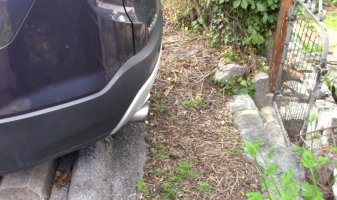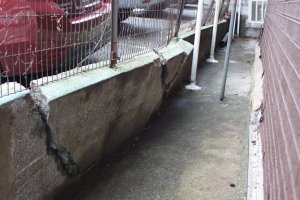Tansy22
REGISTERED
Hello, my city residence in West Virginia is next to a private commercial parking lot so badly designed that cars are hitting my retaining wall, antique fence, and the supports to the 2nd floor bay window. One car smashed a third of the retaining wall this year. I want to be familiar with International building codes for parking lots before I contact my city officials and councilwoman. One space has no wheel stop, two spaces have wheel stops inches away from my structures. A 4th space blocks access to my back gate by an overhanging vehicle.
The city follows International Building Codes, but the parking lot is clearly unsafe.
I saw a quote on this forum and wondered if this would apply to my situation: "1. Each parking space adjoining a wall, column, or other obstruction higher than 0.5 foot shall be increased by two feet on each obstructed side; provided, that the increase may be reduced by 0.25 foot for each one foot of unobstructed distance from the edge of a required aisle, measured parallel to the depth of the parking space".
I'm not clear how far a car should be required to park away from existing structures and how to recommend fixing these parking spaces, plus this iron fence and wall are 150 years old and were not meant to support the weight of the parked vehicles, but that's another problem I hope to fix by having cars parked at least 3 feet further away.
Thank you for explanations and suggestions!
The city follows International Building Codes, but the parking lot is clearly unsafe.
I saw a quote on this forum and wondered if this would apply to my situation: "1. Each parking space adjoining a wall, column, or other obstruction higher than 0.5 foot shall be increased by two feet on each obstructed side; provided, that the increase may be reduced by 0.25 foot for each one foot of unobstructed distance from the edge of a required aisle, measured parallel to the depth of the parking space".
I'm not clear how far a car should be required to park away from existing structures and how to recommend fixing these parking spaces, plus this iron fence and wall are 150 years old and were not meant to support the weight of the parked vehicles, but that's another problem I hope to fix by having cars parked at least 3 feet further away.
Thank you for explanations and suggestions!




